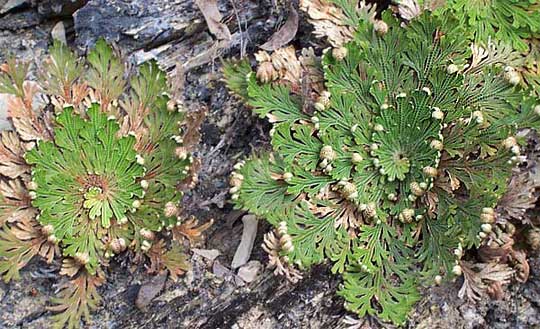Excerpts from Jim Conrad's
Naturalist Newsletter
from the December 11, 2006 Newsletter issued from Sierra Gorda Biosphere Reserve, QUERÉTARO, MÉXICO
RESURRECTION PLANT, GOOD FOR KIDNEYS
Yesterday, exploring a trail leading up the mountain through the scrub I saw a man across the valley wandering along the wooded slope obviously looking for something, occasionally stooping and placing what he'd found into a bag. I had to go see what he was collecting.

The only thing I could see unusual about the spot he'd been in was that here and there thin, stacked layers of slate rock outcropped, and on those rock faces grew a sizable colony of a special kind of spikemoss, genus Selaginella, SELAGINELLA LEPIDOPHYLLA, shown above. I'd seen illustrations of the species, for it's sold as both a potted plant and as medicine.
Selaginella is a non-flowering, spore-producing, moss-like, branching plant that usually creeps over the ground or climbs things, or is sometimes erect. We've them in the North, especially in moist, protected spots such as at cliff bases, mossy areas next to streams, etc. Most Selaginella species are tropical, though. Species of the genus Selaginella are their own kind of thing, having their own plant family.
What's distinctive about the Selaginella I found yesterday was that it was so large, made a pretty rosette with its ferny leaves, but dried up into a ball when dry. Then when it's wet again it opens up like a huge, green snowflake. For this reason the plant is often known as Resurrection Moss, though it's not a moss. You can see two plants with their tips still expanding outward after a rain we'd just had below:
So, why had the fellow been collecting this plant? All over Mexico I see it sold in its dry, balled-up state in "Indian markets" as a medicinal plant, so when I got home I looked up Selaginella lepidophylla in my Las Plantas Medicinales de México. I translate:
In Spanish Selaginella lepidophylla often is known as doradilla.